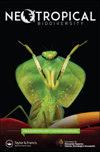The effect of environmental variables on nightly activity patterns of insectivorous bats monitored over ten years in a tropical premontane forest, Costa Rica
IF 0.8
Q4 ECOLOGY
引用次数: 1
Abstract
ABSTRACT We investigated the role of environmental and temporal variables on the activity of 20 species of aerial insectivorous bats at a site in tropical premontane forest in Monteverde, Costa Rica. The primary study site was an opening in secondary forest adjacent to the Children’s Eternal Rainforest. We passively monitored the echolocation calls of all bats detected by an Anabat II detector all night for 1,147 nights from November 2000 through August 2010, from which we were able to identify the species in more than 250,000 bat passes. Simultaneously, we recorded environmental variables. Five species accounted for most of the activity, but the relative frequency of these species fluctuated widely over the ten-year period. The likelihood of any one of the three most common species being present was significantly influenced by wind, rain, phase of the moon, the time of night, the season of the year, and the presence of the other two species. In general, strong winds are associated with an increase in bat activity, moderate to heavy rain seems to halt bat activity, full moon appears to depress bat activity, and bats seem to be most active early in the evening. The number of bat passes at the study site declined over the ten-year period, possibly at least partially due to bat preference for foraging near bright lights, which increased markedly during the period due to development for tourism.哥斯达黎加热带前热带森林中环境变量对食虫蝙蝠夜间活动模式的影响
摘要/ ABSTRACT摘要:本文研究了环境和时间变量对哥斯达黎加蒙特维德热带前山林20种食虫蝙蝠活动的影响。主要的研究地点是毗邻儿童永恒雨林的次生林的一个开口。从2000年11月到2010年8月,我们对Anabat II探测器探测到的所有蝙蝠的回声定位呼叫进行了1147个夜晚的被动监测,从中我们能够在超过25万次蝙蝠通行证中识别出物种。同时,我们记录了环境变量。5种占了大部分的活动,但这些物种的相对频率在10年期间波动很大。三种最常见物种中任何一种出现的可能性都受到风、雨、月相、夜晚时间、一年中的季节以及其他两种物种出现的显著影响。一般来说,强风与蝙蝠活动的增加有关,中等到大雨似乎会阻止蝙蝠的活动,满月似乎会抑制蝙蝠的活动,蝙蝠似乎在傍晚的早些时候最活跃。在10年的时间里,蝙蝠通过研究地点的次数有所下降,至少部分原因可能是蝙蝠喜欢在明亮的光线附近觅食,而在此期间,由于旅游业的发展,蝙蝠的觅食次数显著增加。
本文章由计算机程序翻译,如有差异,请以英文原文为准。
求助全文
约1分钟内获得全文
求助全文
来源期刊

Neotropical Biodiversity
Environmental Science-Ecology
CiteScore
1.80
自引率
0.00%
发文量
39
审稿时长
24 weeks
 求助内容:
求助内容: 应助结果提醒方式:
应助结果提醒方式:


